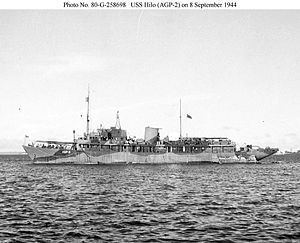Name USS Hilo Acquired 28 November 1941 Decommissioned 3 March 1946 Length 85 m | Ordered as Moana Commissioned 11 June 1942 Launched 1931 | |
 | ||
Laid down 18 August 1930 as the yacht Caroline | ||
USS Hilo (AGP-2) was a Hilo-class motor torpedo boat tender converted from a yacht by the United States Navy for service in World War II. This tender was responsible for providing logistics to torpedo boats in remote areas.
Contents
1930s as "Caroline" and "Moana"
Hilo was originally the yacht Caroline, built in 1931 by Bath Iron Works, Bath, Maine at a cost of 1.5 million dollars for the Victor Talking Machine Company founder Eldridge R. Johnson. At 279 feet in length and 2,400 tons displacement, she was the second largest private yacht in America at that time. The yacht was powered by two 1,500 horsepower diesel engines and had a maximum speed of 15 knots. Johnson offered the use of the Caroline for scientific research including a 1932 archeological expedition to South America and Easter Island and the Smithsonian Institution led Johnson-Smithsonian Deep-Sea Expedition to the Puerto Rico Trench, 1933. In 1938 she was sold to William B. Leeds and renamed the "Moana". The ship was purchased by the Navy on 28 November 1941.
World War II Pacific Theatre operations
Converted to Navy use at Craig Shipbuilding Co., Long Beach, California, she commissioned as USS Hilo (PG-58) on 11 June 1942, Lieutenant Commander F. A. Munroe in command. One of the first ships to be used as a motor torpedo boat tender, Hilo departed Long Beach, California, to load supplies at San Diego, California on 19 June and sailed for Pearl Harbor on 28 June.
The ship arrived Pearl Harbor on 5 July 1942, and was immediately sent to Palmyra Island to tend a torpedo boat squadron there. Hilo remained in the vicinity fueling and providing supplies to the boats then under training until returning to Pearl Harbor again on 4 October. She was soon underway, however, steaming by way of Palmyra Island to Canton Island, where she arrived on 29 October. There she took on passengers and proceeded to Funafuti, arriving on 2 November 1942 with Squadron 1B.
Tending torpedo boats
The ship remained at Funafuti until 25 November, tending torpedo boats and engaging in rescue operations as American forces prepared for the coming assault on the Gilberts and Marshalls. Hilo and other units from Funafuti rescued the gallant Rickenbacker party after their 21-day ordeal in rubber boats on 12 November. She next sailed for Noumea, New Caledonia, arriving on 2 December, and from there escorted four PT boats to Cairns, Queensland, where she moored on 11 December.
Setting up her base in New Guinea
Hilo was then sent to set up the first torpedo boat base in New Guinea, at Milne Bay, arriving on 17 December. Commencing operations soon after their arrival, Hilo's boats contributed to the hard-fought Buna-Gona campaign in New Guinea as allied forces began their return to the Philippines. The boats fired at Japanese ashore, destroyed barges loaded with men and supplies, and even fought submarines in support of the troops ashore. On 13 January 1943, her designation was changed to AGP-2.
In February 1943, Hilo explored the coast for a suitable advance PT boat base, and by the 28th had established one at Kana Kope. The torpedo boats stationed there with Hilo soon had a chance to fight, as Japanese efforts to reinforce their Lae and Salamaua garrisons led to the Battle of the Bismarck Sea from 2–4 March. The tender remained at Kana Kope until late April, when she began to move up the New Guinea coast to various anchorages. As Hilo's torpedo boats continued to take part in the successful New Guinea campaign, Hilo herself underwent many air raids and endured extremes of climate and disease before being relieved on 20 October. The tender sailed to Sydney, Australia, arriving on 13 November, and sailed again on 9 February 1944 for Milne Bay.
Moving her base to New Britain
Hilo again took up her tending duties in the New Guinea area and was transferred to Talasea, New Britain on 26 March. She remained there until 4 June tending two squadrons of torpedo boats, after which she shifted her operations to Mios Woendi and became a command ship for torpedo boat operations in the U.S. 7th Fleet her tender equipment removed. The ship remained there until 6 November.
Supporting PT-boat operations in the Philippines
With the invasion of the Philippines underway, Hilo sailed to Leyte Gulf, arriving on 12 November. During the next months the ships in the Gulf were under almost constant air attack. Hilo was nearly hit on 26 November as kamikaze attacked San Juanico Straits; one kamikaze crashed some 250 yd (230 m) ahead of the tender. Hilo's gunners scored several kills during this period.
Commander, Motor Torpedo Boat Squadrons, 7th Fleet, shifted his flag to Cyrene on 16 January, and for the next nine months Hilo was occupied with passenger voyages to various islands, including Mios Woendi and the Palaus. She departed Samar on 26 October 1945 for the United States via Eniwetok and Pearl Harbor.
Post-war decommissioning
She arrived on 1 December, decommissioned on 3 March 1946 and was sold by the War Shipping Administration to Pillsbury & Martingnoni, San Francisco, California.
Awards
Hilo received four battle stars for service in World War II.
